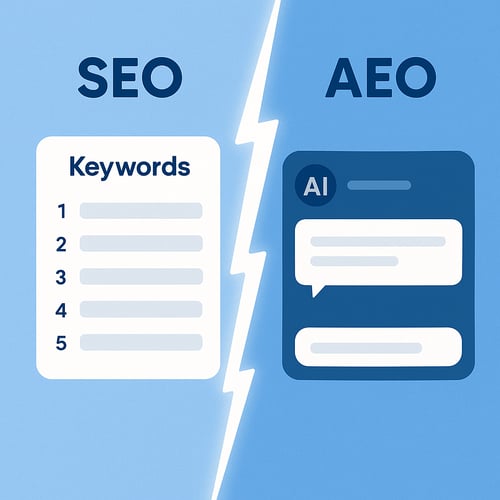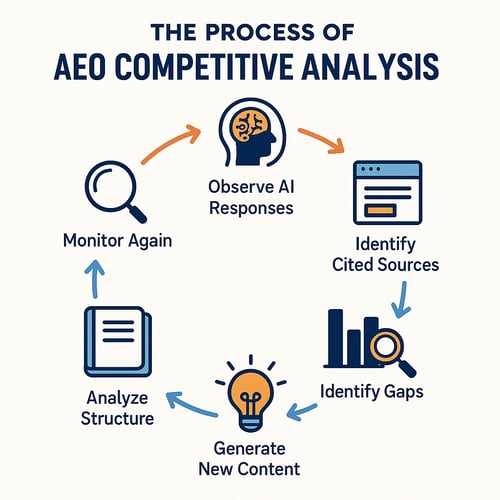The New Battlefield: Why Competitor Analysis for AEO is Different
In the traditional SEO landscape, competitor analysis revolved largely around keyword rankings, backlink profiles, and technical site audits. We’d identify who was outranking us for target keywords, reverse-engineer their strategies, and strive to do better. But in the era of Answer Engine Optimization (AEO), the battlefield has shifted dramatically. It’s no longer just about whose content lands on page one; it's about whose content is chosen by AI models to provide direct answers, summaries, and recommendations. If you haven't yet explored the fundamental shift from SEO to AEO, I recommend starting with [Blog Post 1: The AI Search Revolution: Understanding AEO and Its Impact] for a comprehensive overview.
We needed to fundamentally rethink: if AI is going to synthesize information for users, then our goal is to become the preferred source for that AI. This means our "competitors" aren't just the usual suspects anymore; they are any entity whose content AI models deem authoritative and relevant for a given query.
Tools and Techniques for AI-Driven Competitor Insights
Gathering intelligence in the AEO era requires a blend of familiar tools and new methodologies. My team and I have spent countless hours reverse-engineering these new pathways, and here's what we've found effective:
- Examine AI Overviews (Gemini/Google): Google's AI Overviews are a prime example of AEO in action. Pay close attention to these. Examining Google's AI Overviews (Gemini) to study response structures, preferred formats, and cited sources:
- Structure: How are these answers presented? Are they bullet points, summaries, step-by-step guides?
- Sources: Which websites are consistently cited? What makes their content stand out?
- Coverage: What aspects of the query are covered, and what might be missing?
According to a 2025 study by Search Engine Journal, sites frequently appearing in AI Overviews often share characteristics such as comprehensive coverage, strong internal linking, and a high concentration of E-E-A-T signals.
- Scrutinize Perplexity and other AI tools: Interact with these AI platforms as your target audience would. Use the same queries. Notice what sources they cite and how they phrase their answers. Perplexity, in particular, is excellent for showing sources. This can reveal gaps in content that you can address with new or optimized material.
- Leverage "People Also Ask" (PAA) and Related Queries: The PAA section in Google SERPs has long been a goldmine for understanding user intent. For AEO, it becomes even more critical. Using the 'People Also Ask' Google SERP feature to identify related search queries and understand the broader context of user interests. These often provide direct questions that AI models aim to answer.
- Monitor Industry Forums and Knowledge Bases: AI models often pull information from communities and authoritative hubs. Monitoring industry-related forums and knowledge bases to identify authoritative sites AI models frequently pull from is a savvy strategy. Sites like Reddit are increasingly being leveraged by AI for user-generated insights, especially for nuanced or experiential queries.
- Track Competitor Visibility Changes: AI algorithms are dynamic. Regularly tracking when and how your competitors appear in AI-generated responses can identify successful optimization strategies they might be employing.
Translating Insights into Action
Competitive analysis for AEO isn't just an academic exercise; it's about informing your content and marketing strategy. Once you've identified what makes your competitors successful in AI search, you can:
- Identify Content Gaps: Are AI models consistently citing competitors for questions you should be answering? These are your opportunities to create more comprehensive and authoritative content.
- Refine Content Structure: Adopt the structures (e.g., FAQs, clear summaries) that AI models seem to favor when pulling competitor content.
- Enhance Authority Signals: If competitors are cited for specific data or expert opinions, ensure your content provides even stronger, more credible sources.
- Diversify Content Formats: If AI models are pulling from videos or podcasts for competitors, consider expanding your own content formats.
- Iteration!
In this new era, competitive analysis becomes less about direct imitation and more about strategic differentiation. By understanding how AI interacts with your competitors' content, you can sculpt your own strategy to become the preferred source for AI-generated answers, positioning your brand as an indispensable authority.


